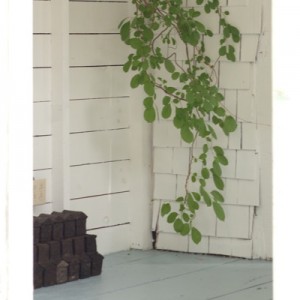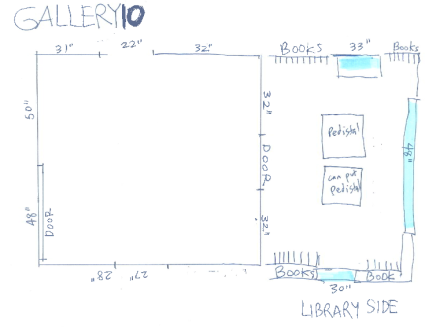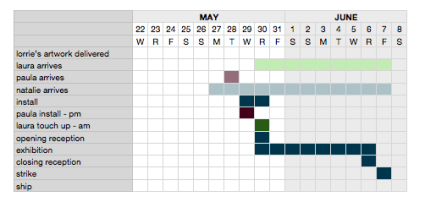some time ago, i wrote a post about project management as an artist. i touched on really just the tip of the iceberg. having been a project manager for over a decade, it is a natural part of my process and the way i see events unfold. it's something i do all the time, whether i'm conscious of it or not. but looking back at what i wrote then, and where i'm at now, i think it's time for an update. because there is so much information to impart, this will need to be a series of posts. if you're interested, check back for more. project management is probably something you already do, whether you realize it or not. you have a show lined up, you figure how much work you'll need to hang. you think about how you're going to get it there. you think about a myriad of little things which will get you from point a to point b, and that is project management. regardless of the project, the same points always get touched on. we've already discussed timelines. let's talk about spaces and planning the exhibition.
and now, tales of a small installation project.
last summer i curated my first exhibition which included my work along with that of three other artists. it was a funky little exhibition in a crazy little space. literally a hand built shack on the grounds of the Castle Hill Center for the Arts on Cape Cod. (if you'd like to see images, go here.) i hadn't been to the space in person and while i knew the space was going to be rough, and small, i was still shocked at just how small it was. but it was okay, because i was prepared and had planned everything ahead of time!
pretty much the first thing i do when i line up a show is to get the floor plan of the space with detailed measurements. in this case, it was a shack which had been built as part of a workshop. the shack was divided into two spaces, one a gallery and the other a library with bookshelves and some exhibition space. while generally, it seems like details aren't necessary for your average show, every bit of knowledge is beneficial. for installations or size specific work, it can be crucial. imagine showing up at a site to install, and finding there is a giant electrical box in the middle of the wall where you'd intended to put up a major piece. or worse, a tiny piece. picture a 9"x16" metal industrial box next to a 6"x6" painting. rarely is that going to work. but if you know ahead, you can plan for it.
for losing ground, gaining perspective, i had selected two other artists in addition to myself whom tend to work either large scale or installation. having gotten a basic floorplan with some dimensions from the venue, i roughed out a floorplan for the space. the largest wall was about 50" wide, with a sloping roofline which cut into the available hanging space. i had to be very careful with what work i was selecting and placing to avoid overwhelming the space and not have the pieces installed at an odd height. my preference is for plenty of whitespace around the work and not crowding. with that knowledge going in, i went back to the artists to find out what work they had available, including dimensions and hanging requirements for installation. i then selected artwork which would fit according to gallery needs, hanging requirements and aesthetic requirements, and started laying out the artwork on my floor plan. there was one piece which i had very much wanted to install, but after a lot of issues with planning, i finally accepted that it wasn't going to work, and that artist and i selected something else. the floorplan was finalized and i let the other artists know which pieces i wanted.
we discussed in detail timelines, when i needed the pieces for installation, how they would be delivered, any installation requirements or instructions, striking the show and how the items would be shipped back, who was going to attend the reception, who could help with the install and strike, and high res images of selected work for the postcards.
game day arrived, we showed up at the space with installation kit in hand and i had a minor freak out about how small the building was. it was so small. BUT! i'd planned and knew that everything would work, so it was only a minor freak out.
 what i hadn't anticipated was that a rather large and slightly aggressive vine had started growing inside the gallery space over the winter! it took up a corner of the space in which i had planned to put a specific piece. the staff from Castle Hill said they were fine with removing the vine if i needed the space, but they were really hoping we could work around it. because the concept of the show revolved around environmental concerns, i thought it was a rather fantastic opportunity which you wouldn't normally have. nature invading our exhibition. so we shuffled some work around, and in the end, it was a wonderful benefit.
what i hadn't anticipated was that a rather large and slightly aggressive vine had started growing inside the gallery space over the winter! it took up a corner of the space in which i had planned to put a specific piece. the staff from Castle Hill said they were fine with removing the vine if i needed the space, but they were really hoping we could work around it. because the concept of the show revolved around environmental concerns, i thought it was a rather fantastic opportunity which you wouldn't normally have. nature invading our exhibition. so we shuffled some work around, and in the end, it was a wonderful benefit.
there was one piece which i hadn't actually been able to finalize before the installation, and honestly, it gave me nightmares. i had no idea if it would fit in with the rest of the show. i didn't know if it would fit in with the space or literally fit IN the space. i planned backup work for the spot just in case. but the work arrived. it was along the lines of what i was expecting and it was huge. but we were able to place it in the space i had originally planned and had previously discussed with the artist. with the help of some accidental and creative space rearrangement (we took/tore down a long worksurface mounted to the wall - so grateful for an awesome, flexible and understanding facility), the piece went floor to ceiling with the worksurface serving as a wonderful low pedestal. the somewhat opaque piece was also wonderfully backlit from a small window behind.
lessons learned:
all knowledge is good and get as much as you can ahead of time. and far enough ahead of time that it's a benefit.
whether it's working with a specific piece, a space or working with different artists, get what you need to plan and implement the show. if it's not working, cut it lo0se and plan something else.
plan all that you can, but be flexible to changing situations during the installation. you never know what might pop up and make the show better.
in the end, all the work looked great, it worked well with the idiosyncrasies of the space, the work all arrived on time and was a breeze to strike. the moral of the story, no matter how much you plan, there will inevitably be hiccups. but by having as much information ahead of time, it's much easier to sort out once they occur.




